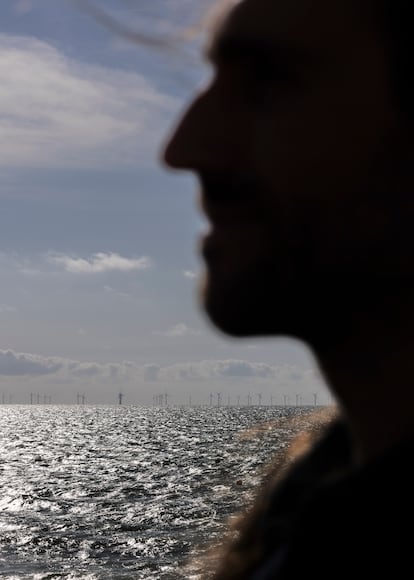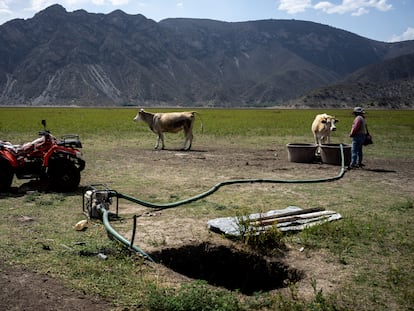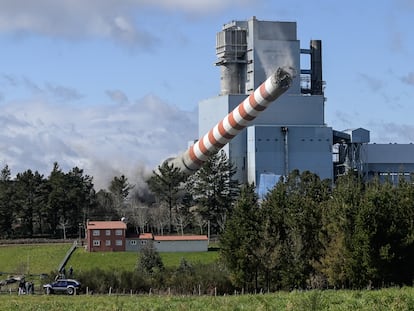David Armstrong McKay, climate crisis researcher: ‘We need to start adapting for the worst-case scenarios’
The author of a recent study on climate tipping points is clear: the situation is already bad, but it could get much worse if we go beyond the point of no return

On an unusually sunny October day in Brighton Beach, southern England — with a severe triggering extinctions of plants and birds in Spain’s Tablas de Daimiel National Park and the government of the Canary Islands suspending classes due to high temperatures — scientist David Armstrong McKay, 34, places his forearm horizontally in front of his face to illustrate climate tipping points: “It’s like a see-saw,” he says. If you push a ball towards the middle of a blanced plank, as long as it does’t reach the pivot, the ball will return to its original position, he explains; but if it goes beyond that threshold, the tilt over the fulcrum will propel it forward even if you stop pushing. At this point, the University of Exeter researcher suddenly drops his forearm until his fingers point to the ground.
Question. Is this what will happen in different parts of the world if global warming reaches certain levels?
Answer. There are lots of different complex systems that have this sort of behavior. And one example, effectively, is the climate system. There are various components and parts of it that can feature these thresholds beyond which self-sustaining changes kick in that keep pushing them to a new state, even if we were to hold global warming just beyond that point, and even if we might reduce it back below by massive carbon dioxide removal to bring temperatures back down a little bit (which is technologically impossible at the moment).
Q. Can you give an example?
A. The Greenland Ice Sheet is mostly melting from the sides, but because it’s so high [right now, on average, it stands over 2,000 meters above sea level], it’s quite cold on the top. It’s like if you climb a mountain: it’s cold at the top, but as you go down, obviously, it gets warmer. So, because it’s gradually melting because of global warming, the ice sheet is getting smaller and shorter, the top is going down in altitude to areas where the air is getting warmer and warmer, so at some point it will reach a point where there won’t be enough snow falling on the top to be able to keep it stable. That is, it will go down to the point that it’s basically melting all over the place constantly, and there will be nothing anyone can do to save it.
Q. And what will be the consequences of that?
A. Well, that whole process would take a long time, probably hundreds or thousands of years, but in the end, it would add up to seven meters to the sea level around the world, which would affect the billions of people who live within that range around the coasts, all around the world. All those cities would have to relocate. Even in this century, it would greatly accelerate sea level rise, something like up to doubling it, if these kinds of processes, both in Greenland and Antarctica, are set in motion.
Q. Is this, then, the turning point that worries you the most?
A. It’s a question I’m often asked, but it’s not easy to answer, because I’m worried about all of them. The process of the ice sheet [not returning], especially in West Antarctica, could happen sooner and faster than Greenland, which would mean sea level rise of three meters over hundreds of thousands of years. But the collapse of some parts of the North Atlantic convection [specifically the Subpolar Gyre, part of the Atlantic meridional overturning circulation, or AMOC, the main climate-regulating ocean current], which may happen within a few decades, and quite quickly — it’s not clear, but some models suggest it could happen with a two-degree temperature increase — would cool the region by a few degrees and change many of the weather patterns. And, consequently, change everything that depends on them, such as agriculture, which would be chaotic for Europe. Even without going into the negative socio-economic impacts, the mere loss of coral reefs would be a tragedy for life on Earth.

Armstrong McKay sips a latte as he talks, sitting on one of the promenade terraces at one of England’s most iconic beaches, in the town he decided to move to during the pandemic. There’s an old, half-sunken pier on one side; on the other, a still-standing pier with an amusement park, and, in the background, a handful of windmills jutting out of the sea toward the horizon. Dressed in a flannel shirt and jeans, with his long hair tied back in a ponytail, he’s one of many young scientists who struggle not to give up in the face of precarity before landing a permanent position at a university or research institute. With a degree in geophysics and an extensive background in the study of the Earth’s palaeoclimate, the planet’s resilience and its interrelation with human dynamics, he confesses to being surprised by the impact of the study he presented last September on climate tipping points: “It’s been a bit of a rollercoaster” he says. A few years ago, while working with the Stockholm Resilience Centre, Armstrong McKay proposed to his current boss at Exeter, Professor Timothy Lenton, that he update the work with which he had laid the foundations for the field of climate tipping points back in 2008. Thus, after synthesizing the results of more than 200 studies to estimate the thresholds of warming for each of these points, together with eight colleagues, including Lenton, he published a paper in the journal Science entitled “Exceeding 1.5 °C of global warming could trigger multiple climate tipping points.”
Armstrong McKay talks about this work with the care and patience of a generation of scientists convinced that it’s not enough to just “do science and publish it in good journals in the hopes that policy makers will read it,” but that efforts must also be made “to try to explain it to people so that they understand it and can do something with the information.” That is why he tend to dwell on a key issue, the Amazon rainforest, whose threshold for warming, to reach the point of no return, still seems far away, and yet, as human-induced deforestation continues to devour it, that moment is potentially fast approaching.
Q. What would a world without the Amazon rainforest be like?
A. For a start — as with the coral reefs — it would be tragic to lose this incredible feature of this planet; they have evolved over millions of years, and some species that have been there for many millions of years are on the brink of extinction. And it just feels to me a kind of cosmic crime. But also, if vulnerable parts of the Amazon rainforest were to disappear, it would release something like 30 billion tons of carbon, which is like several years’ worth of human emissions. That, even without being as massive an amount as compared to the continued burning of fossil fuels, would add 0.1 degrees to warming, which is something we can’t afford right now, given that we’re at 1.2 and heading towards 1.3 and we’re supposed to keep things at 1.5...
Q. The problem is that calculations, however good they may be, always maintain a very high level of uncertainty, i.e. we do not really know whether we have already passed any of these points of no return.
A. It’s important to talk about the uncertainty around these issues. In our paper last year, in the graphs, we plotted the minimum estimates in yellow, the color gradually turned to red when it becames more likely [to reach the threshold], and then turned very red when it becomes very likely. From there, we used the most common values to calculate, for example, that the balance in the case of the ice sheet will probably tip beyond [the increase of] 1.5 degrees of warming. But it could happen with 0.8 degrees, in which case it obviously would have already happened. That’s the thing: we don’t actually know exactly when it will tip, but we know that the probability is increasing as that temperature goes up. And it could already be happening.”
Q. And we’ll know for sure in 10, 15, 20 years....
A. We need some time to pass before we can be really sure. It’s like walking through a minefield: the further you go, the more likely you are to hit a mine, but you don’t really know for sure when you will. In that space of uncertainty, some politicians might be tempted to say: well, if we don’t know exactly when it’s going to happen, should we really be worried about it or should we focus on the things we do know for sure? But what we do know for sure is that as we get warmer, we get closer to catastrophic events, which should be motivation enough to keep the temperature rise as low as possible so that we don’t cross those thresholds.
Q. Is this why you think the climate tipping points approach has been so successful?
A. It’s worth stressing that climate change is already bad now. We don’t need tipping points to motivate us to limit global warming by 1.5 degrees. But climate tipping points give us a measure of the long-term change we are bringing about; we could be changing the system in ways that will make life difficult for our descendants for many, many generations. Many people seem surprised when you explain to them that climate change is no longer largely reversible; they seem to be thinking: well, at some point something will be invented that will fix everything, maybe we can suck up all the carbon dioxide and go back to zero. But even in the unlikely event that that happens, if we go beyond those tipping points, there will be no reversal of those changes.
Q. This is an extremely serious situation that scientists like yourself are constantly trying to make people understand. However, you also speak of positive turning points.
A. It’s true, sometimes when I give talks, I play the bad cop, focusing on the bad news about tipping points, and another colleague plays the good cop, explaining the positive social tipping points. This is something that some of my colleagues at Exeter are working on a lot more: looking for positive spaces from a social, economic, technological point of view.... For example, solar or electric car technology is so widespread that even if governments were to withdraw subsidies, prices would not go up and mass adoption would continue. Or how the social protest that Greta Thunberg started in 2018 has become a self-sustaining social movement.
Q. But beyond social or economic tipping points, there is talk of climate tipping points that may have positive effects, such as the fact that the Sahel in central Africa may be greening up.
A. This is interesting, but unclear. It may be perceived as an objectively good thing that the Sahel may become greener, but it is much more complex than that. For a start, it would not be the whole region: some western parts would dry out and the Gulf of Guinea, West Africa, where there is currently rainforest, would probably tend to dry out a bit as well. But, in addition, in the rest of the region there are biodiverse systems that have their own value, to which their inhabitants are adapted and where changes — in fact, right now, the jump in parts of Africa is from a dry savanna to a kind of bush encroachment — may further destabilize an area that is already quite unstable.
Q. In any case, it seems that there is this trend of looking for positive elements to introduce in the messages on climate change, perhaps because if everything is always negative, some people simply stop listening.
A. Yes, and that’s why I think it’s important to talk about social tipping points. I’m also trying to contribute to this change by disseminating climate tipping points in a precise way. Because there are many people who are very fatalistic and say: there is nothing we can do about it. And yes, we can, even if some really dramatic tipping points are triggered — and sea levels rise, for example, and reefs disappear — it will not be a game-over situation, because it will not substantially increase global warming and we can still try to limit it so that no more tipping points are exceeded.
Q. Okay, instead of giving up, in this complex space full of uncertainties, what can be done to improve the situation?
A. The main message has to be: the lower we can keep the warming, especially the maximum peak warming, the better. This reinforces the Paris Agreement goal of limiting warming to 1.5 degrees, and the need to reduce greenhouse gas emissions to zero. This would imply a rapid phase-out of the fossil fuel industry, since it is responsible for about two-thirds of emissions. This is not yet happening, nor are other things that we already know are important and that have to do with changing the way we use land and agriculture. So it would also be very important on the other hand to start planning for adaptation to those changes that can trigger tipping points. We have to start thinking about extreme scenarios where sea defenses will not be sufficient at the end of the century, for example. And adaptation cannot be done in anticipation of a flat, gradual process, but with the possible worst-case scenario in mind too. Let’s go back to the Amazon; it’s certainly threatened by climate change, which brings more droughts and more fires, but also by deforestation, and if the Amazon countries unite to stop it, the situation could be much improved. At the same time, ecological restoration could also be seriously addressed: a recovered rainforest, in a couple of decades, will not be the same as the old one, it will not be as diverse or as functional, but it can probably maintain some of its feedbacks, in particular the ability to generate some of its own rain. So, if you can restore some of these forests, protect them and promote agroforestry as an alternative industry to cattle ranching, you could move away from one of the climate tipping points.
Sign up for our weekly newsletter to get more English-language news coverage from EL PAÍS USA Edition
Tu suscripción se está usando en otro dispositivo
¿Quieres añadir otro usuario a tu suscripción?
Si continúas leyendo en este dispositivo, no se podrá leer en el otro.
FlechaTu suscripción se está usando en otro dispositivo y solo puedes acceder a EL PAÍS desde un dispositivo a la vez.
Si quieres compartir tu cuenta, cambia tu suscripción a la modalidad Premium, así podrás añadir otro usuario. Cada uno accederá con su propia cuenta de email, lo que os permitirá personalizar vuestra experiencia en EL PAÍS.
¿Tienes una suscripción de empresa? Accede aquí para contratar más cuentas.
En el caso de no saber quién está usando tu cuenta, te recomendamos cambiar tu contraseña aquí.
Si decides continuar compartiendo tu cuenta, este mensaje se mostrará en tu dispositivo y en el de la otra persona que está usando tu cuenta de forma indefinida, afectando a tu experiencia de lectura. Puedes consultar aquí los términos y condiciones de la suscripción digital.
More information
Archived In
Últimas noticias
The new victims of the Republican war on Obamacare: Millions hit by soaring health insurance premiums
A country divided on migrant rights: Some US states expand protections while others restrict them
Venezuela authorizes the release of another 87 political prisoners
There is as much life left to discover on planet Earth as that which is already known
Most viewed
- David King, chemist: ‘There are scientists studying how to cool the planet; nobody should stop these experiments from happening’
- Reinhard Genzel, Nobel laureate in physics: ‘One-minute videos will never give you the truth’
- Oona Chaplin: ‘I told James Cameron that I was living in a treehouse and starting a permaculture project with a friend’
- Sinaloa Cartel war is taking its toll on Los Chapitos
- The Interoceanic Train, the Mexican alternative to the Panama Canal











































